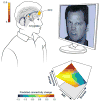Pediatric Irritability: A Systems Neuroscience Approach
- PMID: 28274677
- PMCID: PMC5366079
- DOI: 10.1016/j.tics.2017.02.002
Pediatric Irritability: A Systems Neuroscience Approach
Abstract
Irritability, defined as an increased propensity to exhibit increased anger relative to one's peers, is a common clinical problem in youth. Irritability can be conceptualized as aberrant responses to frustration (where frustration is the emotional response to blocked goal attainment) and/or aberrant 'approach' responses to threat. Irritable youth show hyper-reactivity to threat mediated by dysfunction in amygdala, medial prefrontal cortex (mPFC), anterior cingulate cortex (ACC), insula, striatum, and association cortex. Irritable youth also show abnormalities in reward learning, cognitive control, and responses to frustration. These abnormalities are mediated by circuitry that includes the inferior frontal gyrus (iFG), striatum, ACC, and parietal cortex. Effective treatments for irritability are lacking, but pathophysiological research could lead to more precisely targeted interventions.
Keywords: aggression; anger; frustration; irritability; reward; threat.
Published by Elsevier Ltd.
Figures



Similar articles
-
Traits of empathy and anger: implications for psychopathy and other disorders associated with aggression.Philos Trans R Soc Lond B Biol Sci. 2018 Apr 19;373(1744):20170155. doi: 10.1098/rstb.2017.0155. Philos Trans R Soc Lond B Biol Sci. 2018. PMID: 29483341 Free PMC article. Review.
-
Irritability in Youths: A Translational Model.Am J Psychiatry. 2017 Jun 1;174(6):520-532. doi: 10.1176/appi.ajp.2016.16070839. Epub 2017 Jan 20. Am J Psychiatry. 2017. PMID: 28103715 Review.
-
Context-dependent amygdala-prefrontal connectivity during the dot-probe task varies by irritability and attention bias to angry faces.Neuropsychopharmacology. 2022 Dec;47(13):2283-2291. doi: 10.1038/s41386-022-01307-3. Epub 2022 Jun 1. Neuropsychopharmacology. 2022. PMID: 35641787 Free PMC article.
-
Brain Mechanisms of Attention Orienting Following Frustration: Associations With Irritability and Age in Youths.Am J Psychiatry. 2019 Jan 1;176(1):67-76. doi: 10.1176/appi.ajp.2018.18040491. Epub 2018 Oct 19. Am J Psychiatry. 2019. PMID: 30336704 Free PMC article.
-
A Latent Variable Approach to Differentiating Neural Mechanisms of Irritability and Anxiety in Youth.JAMA Psychiatry. 2018 Jun 1;75(6):631-639. doi: 10.1001/jamapsychiatry.2018.0468. JAMA Psychiatry. 2018. PMID: 29625429 Free PMC article.
Cited by
-
Prefrontal modulation of frustration-related physiology in preschool children ranging from low to severe irritability.Dev Cogn Neurosci. 2022 Jun;55:101112. doi: 10.1016/j.dcn.2022.101112. Epub 2022 May 3. Dev Cogn Neurosci. 2022. PMID: 35576725 Free PMC article.
-
Traits of empathy and anger: implications for psychopathy and other disorders associated with aggression.Philos Trans R Soc Lond B Biol Sci. 2018 Apr 19;373(1744):20170155. doi: 10.1098/rstb.2017.0155. Philos Trans R Soc Lond B Biol Sci. 2018. PMID: 29483341 Free PMC article. Review.
-
A New Paradigm to Investigate the Neuroscience of Irritability in Youth.Biol Psychiatry Glob Open Sci. 2024 Mar 15;4(2):100288. doi: 10.1016/j.bpsgos.2024.100288. eCollection 2024 Mar. Biol Psychiatry Glob Open Sci. 2024. PMID: 38501117 Free PMC article. No abstract available.
-
A single dose of fluoxetine reduces neural limbic responses to anger in depressed adolescents.Transl Psychiatry. 2019 Jan 21;9(1):30. doi: 10.1038/s41398-018-0332-2. Transl Psychiatry. 2019. PMID: 30664639 Free PMC article.
-
Systematic Review and Meta-analysis: Task-based fMRI Studies in Youths With Irritability.J Am Acad Child Adolesc Psychiatry. 2023 Feb;62(2):208-229. doi: 10.1016/j.jaac.2022.05.014. Epub 2022 Aug 6. J Am Acad Child Adolesc Psychiatry. 2023. PMID: 35944754 Free PMC article.
References
-
- Peterson BS, et al. Risk factors for presenting problems in child psychiatric emergencies. J Am Acad Child Adolesc Psychiatry. 1996;35:1162–1173. - PubMed
-
- American Psychiatric Association. Diagnostic and Statistical Manual of Mental Disorders: DSM-5. American Psychiatric Publishing; 2013.
Publication types
MeSH terms
Grants and funding
LinkOut - more resources
Full Text Sources
Other Literature Sources
Medical

